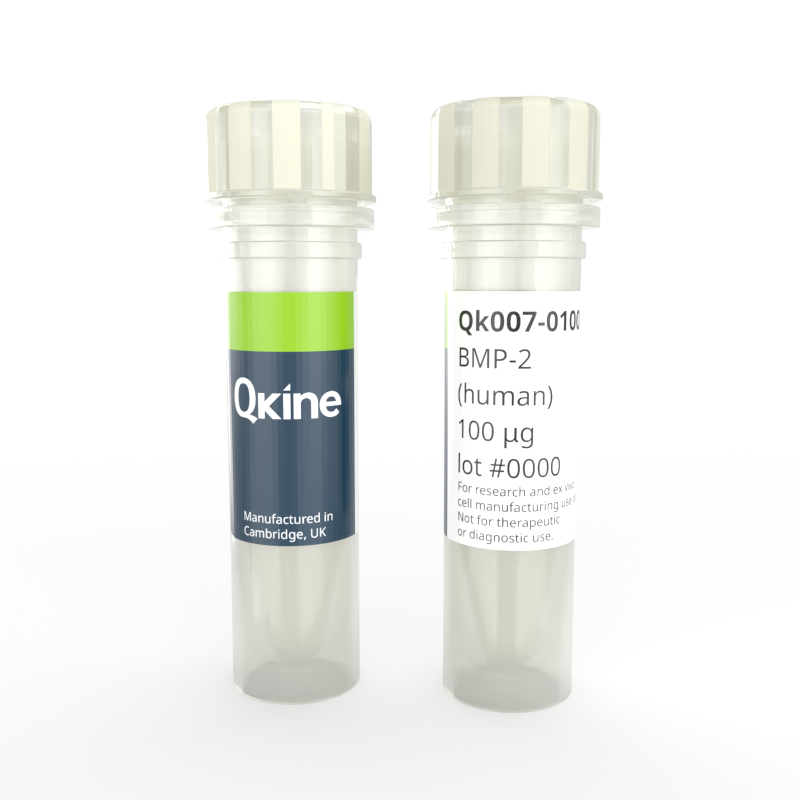Recombinant human BMP-2 protein
QK007
Brand: Qkine
Human recombinant BMP-2 protein (bone morphogenetic protein 2) protein is member of the TGFβ family and a key regulator of embryogenesis and potent differentiation factor of embryonic stem cells (ESC) and induced pluripotent stem cells (iPSC) towards endoderm fates. BMP-2 plays roles in the differentiation of mesenchymal cells to adipocytes, epithelial cancer EMT, chondrogenesis and regulation of neuronal and glial cell development.
Qkine recombinant BMP-2 is a 26 kDa disulfide–linked bioactive highly pure dimer comprised of the mature domain of human BMP-2 protein, animal origin-free (AOF) and carrier protein-free.

Currency:
| Product name | Catalog number | Pack size | Price | Price (USD) | Price (GBP) | Price (EUR) |
|---|---|---|---|---|---|---|
| Recombinant human/mouse/rat/bovine/porcine BMP-2 protein, 25 µg | QK007-0025 | 25 µg | (select above) | $ 280.00 | £ 205.00 | € 240.00 |
| Recombinant human/mouse/rat/bovine/porcine BMP-2 protein, 50 µg | QK007-0050 | 50 µg | (select above) | $ 410.00 | £ 305.00 | € 357.00 |
| Recombinant human/mouse/rat/bovine/porcine BMP-2 protein, 100 µg | QK007-0100 | 100 µg | (select above) | $ 620.00 | £ 455.00 | € 532.00 |
| Recombinant human/mouse/rat/bovine/porcine BMP-2 protein, 500 µg | QK007-0500 | 500 µg | (select above) | $ 2,500.00 | £ 1,840.00 | € 2,150.00 |
| Recombinant human/mouse/rat/bovine/porcine BMP-2 protein, 1000 µg | QK007-1000 | 1000 µg | (select above) | $ 3,950.00 | £ 2,900.00 | € 3,388.00 |
Note: prices shown do not include shipping and handling charges.
Qkine company name and logo are the property of Qkine Ltd. UK.
Alternative protein names
Species reactivity
human
species similarity:
mouse – 100%
rat – 100%
porcine – 100%
bovine – 100%
Summary
- High purity human bone morphogenetic protein 2, BMP-2 (Uniprot: P12643)
- 26 kDa (dimer)
- >98%, by SDS-PAGE quantitative densitometry
- Expressed in E. coli
- Animal origin-free (AOF) and carrier protein-free
- Manufactured in Qkine's Cambridge, UK laboratories
- Lyophilized from acetonitrile, TFA
- Resuspend in 10 mM HCl (Reconstitution solution A) at >50 µg/ml, add carrier protein if desired, prepare single-use aliquots and store frozen at -20 °C (short-term) or -80 °C (long-term)
Featured applications
- Differentiation of human pluripotent stem cells towards extra-embryonic endoderm, mesenchymal, neural lineages, and chondrocytes
Bioactivity
BMP-2 activity is determined using the BMP-2 responsive firefly luciferase reporter assay in stably transfected HEK293T cells. Cells are treated in triplicate with a serial dilution of BMP-2 for 6 hours. Firefly luciferase activity is measured and normalized to the control Renilla luciferase activity. EC50 = 0.3 nM (7.8 ng/mL). Data from Qk007 lot #10.

Purity
BMP-2 migrates as a single band at 26 kDa in non-reducing (NR) conditions and 13 kDa as a single monomeric species upon reduction (R). No contaminating protein bands are visible. Purified recombinant protein (7 µg) was resolved using 15% w/v SDS-PAGE in reduced (+β-mercaptothanol, R) and non-reduced conditions (NR) and stained with Coomassie Brilliant Blue R250. Data from Qk007 lot #010

Further quality assays
- Mass spectrometry: single species with expected mass
- Analytical reversed-phase: single sharp peak
- Endotoxin: <0.005 EU/μg protein (below level of detection)
- Recovery from stock vial: >95%

Qkine BMP-2 is more biologically active than a comparable alternative supplier protein. Bioactivity was determined using a BMP-2-responsive firefly luciferase reporter assay in stably transfected HEK293T cells. Cells were treated with a serial dilution of Qkine BMP-2 (Qk007, green) or alternative BMP-2 (supplier B, black). Firefly luciferase activity was measured and normalized to the control Renilla luciferase activity. Data from Qk007 lot #204510.
Protein background
Bone morphogenetic protein 2 (BMP-2) is a member of the BMP subgroup of the transforming growth factor beta (TGF-β) superfamily. It plays numerous roles in the developing embryo, such as embryonic patterning along the dorso-ventral axis, organogenesis, limb bud formation, and bone and cartilage growth. BMP-2 protein is a potent differentiation factor and directs human pluripotent stem cells towards extra-embryonic endoderm, mesenchymal and neural lineages, and chondrocytes [1] . Recombinant BMP-2 protein induces bone and cartilage formation in vitro and chondrogenesis in human adult mesenchymal stem cells [2].
Human bone morphogenetic protein 2 (BMP-2) is synthesized as a preproprotein consisting of N-terminal signal peptide, 259 amino acid residue pro-domain and 114 residue mature domain. Proteolytic removal of the propeptide enables mature BMP-2 protein to form active disulfide-linked homodimers, and heterodimers with BMP7.
Mature human BMP-2 protein shares 100% amino acid sequence identity with mouse and rat BMP-2. It also shares 85% amino acid sequence identity with the related protein, BMP-4, and less than 51% identity with other BMPs.
Background references
- Pera, M. F. et al. Regulation of human embryonic stem cell differentiation by BMP-2 and its antagonist noggin. J. Cell Sci. 117, 1269–80 (2004). doi.org/10.1242/jcs.00970
- Schmitt, B. et al. BMP2 initiates chondrogenic lineage development of adult human mesenchymal stem cells in high-density culture. Differentiation. 71, 567–77 (2003). doi.org/10.1111/j.1432-0436.2003.07109003.x
Publications using Recombinant human BMP-2 protein (Qk007)
CD1530, selective RARγ agonist, facilitates Achilles tendon healing by modulating the healing environment including less chondrification in a mouse model
Yimiti D, Uchibe K, Toriyama M et al.
DOI: 10.1002/jor.26006
High resolution multi-scale profiling of embryonic germ cell-like cells derivation reveals pluripotent state transitions in humans
Stucchi S, Sepulveda-Rincon LP, Dion C et al.
DOI: https://doi.org/10.1101/2025.01.14.632914
Hydrostatic pressure promotes chondrogenic differentiation and microvesicle release from human embryonic and bone marrow stem cells
Luo L, Foster NC, Man KL et al.
DOI: 10.1002/biot.202100401
Sex-specific chromatin remodelling safeguards transcription in germ cells
Huang TC, Wang YF, Vazquez-Ferrer E et al.
DOI: 10.1038/s41586-021-04208-5